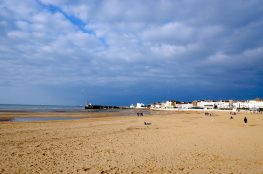One of the things we wanted to do is see a little bit of Papua and it’s people, so we flew to Wamena. It is only accessible by plane, the road from Jayapura was given up on after a landslide several years back.
I have been pondering for the last weeks how to attempt to write this post. So far, it was my least favourite place. Though this was the place I was most excited to see mainly because it’s advertised as being able to see traditional village, the original Papuan tribes and possibly interact with them.
What I ended up experiencing, was a city with clear separations between the Papuans and the “yellow” people, Indonesians that came mainly from Java. The atmosphere was eery, it seemed every Papuan was eating betel nut, and a giant white cross comparable to a control centre is overlooking the city.
It became clear that most Papuans don’t like the situation. A situation where the other Indonesians organise the city and life for them, running businesses, making the money, and also, where tourists come to visit local villages and to meet the “real” Papuans. We, like probably many other tourists, wanted to visit a local village, but were forbidden entry by some locals. I am not sure whether that was because we were tourists or whether there was an issue with our guide. We couldn’t get a clear answer.
A bit of history, Papua used to be under Dutch rule and then annexed by Indonesia in 1969. Before that, the Dutch started a transmigration programme to move people from densely populated areas of the country to less populated areas, such as Papua and West Papua. This programme was only ended three years ago. Missionaries were also busy converting Papuans from animism or other beliefs to Christianity, and a geologist found the biggest gold mine (there’s also a load of copper) to date near Puncak Jaya, the Grasberg Mine. Naturally, it’s run by an American company you’ll have never heard of that also happens to deal with Petroleum.
You can imagine that the local, indigenous people wouldn’t be too happy about the situation and I suppose every white person coming to town wanting to visit the locals is just a reminder of their situation. If you google Papua, you’ll find that in recent news this sentiment was confirmed.
After our failed attempt to visit a traditional village, we ventured to Jiwika by hitchhiking there. A minibus of teenagers, some drunk likely escaping the Sunday rituals, dropped us off at Jiwika. It’s the hotspot for white people to see a traditional village with the locals wearing traditional outfits. Suddenly, local women surrounded us, first wearing tops, then none to resemble their past cultural lives. They have a mummy in the village to be whipped out any time a tourist comes, though we politely declined. We read about a saltwater well, Air Garam, which included a hike. The online world recommended hiring a local woman as a guide, so we did after some negotiating.
Though the video below doesn’t show it, it wasn’t the best of experiences going up to the wells and have the woman show us how they originally got salt. It was not at all about getting to know their culture, but more about the money. It was a running theme throughout our stay, at the same time, it is also a conflict and contradiction for the locals. They don’t want to be taken advantage of, but they need the money, so they “sell” their culture to a point where it feels like you need to buy air to breathe as well.
It is such a shame that the current situation is like this and I wish I had a better experience and feeling leaving Wamena. It’s infuriating and sad, really.




15 October 2018
[…] was one afternoon, much needed, where I captured my thoughts on Wamena in Papua but I didn’t manage to wrap up Indonesia with the last destination – […]